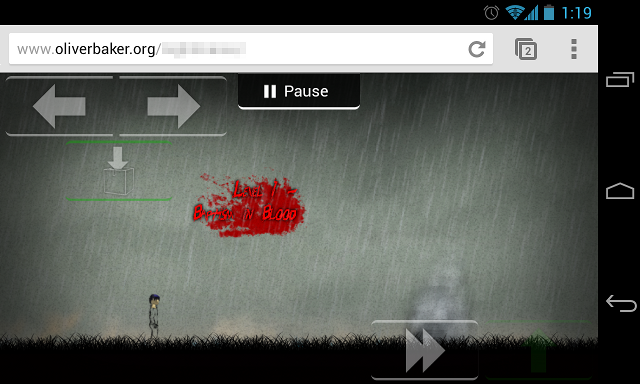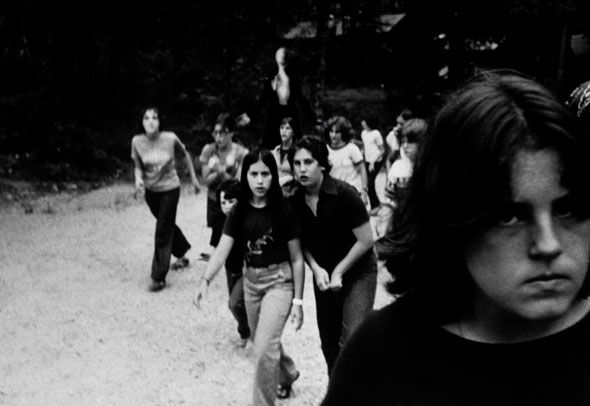Transcript
[+] Who is Professor Murphy?
Do you want to talk about who you are, and what you do?
Yes! That will be interesting, because it'll be different. I teach primarily Renaissance British Literature; so Shakespeare, and Milton, Johnson and Dunn, things like that.
But while I was in grad school, I got to teach Detective Fiction as a teaching assistant, and the professor there was really into making sure his teaching assistant could do things on their own, so we ended up doing a lot of extra teaching, and I totally loved it.
So I thought, "Oh yeah, I'm definitely going to teach this on my own." I taught it on my own in grad school after I was done with his class, and then I taught it once before here, and now I'm teaching it again next semester.
[+] Does the act of reading affect the scare factor?
So I guess the first [question was], "How do books manage to be scary when [the readers] can read slower, or put the book down for a bit, while in a movie or something [the readers] are obligated to continue watching?"
You know, I actually don't really see, at least the scary part, as that different based in print or film; it's just that they've used different techniques to do the same thing. For example, in a film, you have spooky music, you have closed doors, or a character looking in a mirror, and you know something's going to come up behind them or something like that, right? But in a book there are the same kinds of signals, they're just textual signals usually.
This is a very simple example, but often you will have a main character who "has never [done] something", whatever that is, then you can pretty much expect, that the thing that they've never done, that the narrator has told us, that's going to be the sphere they have to face. So you can kind of see it coming in the same way, whereas with a film, you can cover your eyes and you can still hear what's going on.
With a book you can put it down, I remember doing this with The Shining when I was younger, being like, "I can't be in the same room as that book!" and I would put the book in another room, and I would go sleep in that room, and then it was "Okay, but I just have to read one more chapter."
It's the same that it would be with a love story, or with whatever it is that you want to see how it keeps going as it draws you in, but also freaks you out.
Yeah, because like you mentioned with the mirror, that's something that I see a lot in the movies. A character is looking in a mirror, they bend down.. and then you close your eyes. So it's interesting that, as you say, there's a similar, but obviously different, [device] with books.
Right, so while they're very different media, obviously, they both have formulas that they operate with; and that's the formula Scream is making fun of. The texts have the same kind of formulas built into them. If you read enough of them, like if you read all of Sherlock Holmes, you start to get familiar with what you should expect to happen. So film and print have different things you should expect to happen, but you get scared none-the-less.
[+] Goosebumps and choose-your-own-adventure books
[Regarding] choose-your-adventure books, like Goosebumps books I read when I was a kid, how do you think those dynamic stories contribute to the scare factor, or the narrative?
So, I love choose-your-adventure books, but this is not a normal thing for a literature professor to say. I think that it's wonderful, because it makes the reader engage in a kind of active reading. But it also is a losery, because the author has chosen all the possible paths, so in a sense, it's just that they wrote seven books. So it makes the reader feel more active, but they're not as active. So there's that kind of weird side to the choose-your-adventure.
But I think it's the same [reason] that people ride roller coasters. So you stand outside the roller coaster, and you see what it looks like, you imagine: "What is it going to feel like, when it gets to that part?". Or if you have a roller coaster like Space Mountain, that's inside; and so all you see is this building that's sort of shaped in a certain way, but you have no idea what to expect, and when you get on it you can't see it. So it's a different kind of scare, but you're not less scared on the ones you can see. It's not like you get on that roller coaster and it doesn't feel as scary. It still feels scary. So there's something about predictability that doesn't negate scariness.
Yeah, and I think the same goes for the difference between how if you see a trailer for a movie, but when you watch a movie, you're still going to be scared.
[+] Does your imagination when reading enhance the scare factor?
The next [question] is about imagery, and how books let you use your imagination more. The question [is], how does this affect the thriller genre, and is anything lost in print media?
The problem is, that I think that using our imagination can take different forms. So good film directors can make you use your imagination in a way that's similar to reading a novel. Maybe not exactly like it, but that can make you [make] the [same] kind of connections.
There was that French movie, Cache, that didn't have as much exposition (this is one of my problems with a lot of the scientific thrillers, like CSI or Bones, where they spend a lot of time doing exposition). You need to figure out how to build your exposition into your story frame.
I don't think it's just by nature of the medium that you are not able to let the reader or viewer use their imagination. It's just a matter of what kinds of choices people make. The difference between something like Saw and something like Cache. Those are very different kinds of movies, they're asking for something different, they're scaring you in a different way. This is true in novels as well. So if you have a novel, for example, by James Patterson, if you've read enough James Patterson novels, you kind of know how it's going to go, you know where it's going to go up and where it's going to go down.
Whereas, in his heyday, Stephen King, (and his heyday is not now) did this amazing thing where he captured a certain sense of the American culture in the late 70s, and he was able to turn that into something to be afraid [of]; it's just masterful. So he was much better at that than, I would argue, James Patterson is; he was just telling the thriller story. But both of those things scare you. They just kind of scare you in a different way: one makes you do a little bit more brain work; which is why I actually don't like Stephen King's later novels (like Tommy Knockers, and up), because he stopped letting me do some of that thinking. His books got bigger, he started doing more.. just.. descriptions of rooms, oh my god. That is the thing that makes it a different scary.
Still though, in the James Patterson novel and in the Dan Brown novel, you go "*gasp* What's going to happen?" you know. But it's not quite the same thing as the end of Cache, [where] you still didn't really know what happened, and you were still freaked out.
Right, and you were thinking [that], because it wasn't explicitly said, your imagination is [running] wild on what could have happened.
[+] Do you have a favorite thriller novel or writer?
Do you have any [thriller] writers or books?
Yes, I would say Stephen King in his heyday: Carrie, Cujo was pretty terrible, but I still loved it and I couldn't help myself. Lately though, [I've] become a pretty avid reader of thrillers and detective stories. But what that means is that I've become really familiar with the formula. So now I can't really have a favorite because I'm kind of dull.
[+] Films or Novels?







